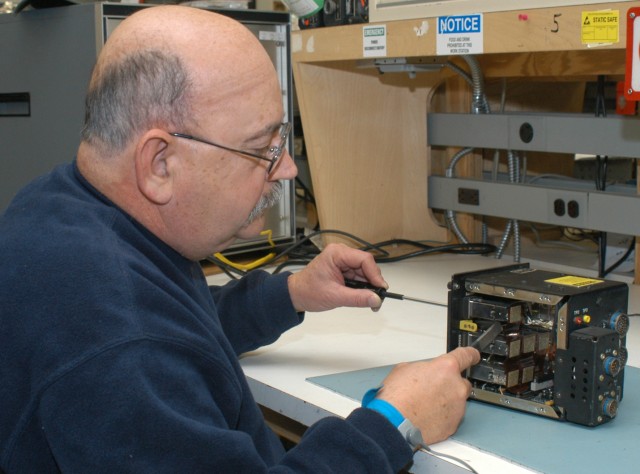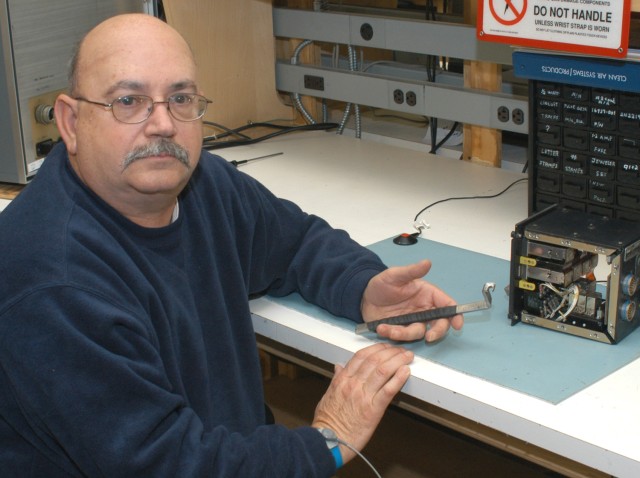A simple tool designed by an employee here has solved a frustrating problem for avionics technicians.
Personnel in the Flight Control Systems Branch repair and test flight control panels used in Black Hawk helicopters. Part of the work involves removing a faceplate, which means removing several screws held in place by nuts. The branch is part of the Command, Control and Computers/Avionics Directorate's Avionics Division.
"Two of the nuts, called press nuts, are located behind the front panel and were very difficult to remove," said Don Cragle, an electronic instrument mechanic in the Air Communications/Instruments Branch. "The space between the components is too small to allow standard tools to grip the nuts to remove the screws."
Technicians were using extra-long needle nose pliers and surgical clamps to grip the press nuts, which sometimes damaged inner components. Cragle said the press nuts, which are pressed into an indentation to lock them in place, would often come loose, making it very difficult to remove the screw. Also, the press nuts are flat only on two sides, not the usual five or six sides, making it harder to get a grip on them.
"The nut would strip and turn with the screw," he said. "When that happened, a grinding wheel or drill was used to remove the screw head and extract the remainder of the screw and press nut from the rear of the panel, which often damaged the front panel. Sometimes the heat from the drill would melt it. Once it's damaged, it's thrown away."
Several of the panels were ruined. Pete Carr, formerly a worker in the branch, asked Cragle if he could help.
"He knew I had been a machinist, a tool and die maker, and a sheet metal mechanic," Cragle said. "Also, I had done the same job years ago, only we weren't repairing nearly as many."
Cragle agreed to try to build a tool that would solve the problem. He designed a 1/8-inch open-end wrench that is angled so it will fit easily into the tight spaces and grip the press nuts on their flat sides. With the wrench in place, it is easy to turn out the screw from the front of the panel in the normal manner.
"Using the former methods, it took about 15 minutes to remove two screws and two nuts," Cragle said. "The wrench cuts that to less than 30 seconds with no risk to components."
The entire flight control panel costs $10,000. The front panel alone costs $800. Damage avoidance, plus time and cost to make the tool (about $1 worth of steel and 30 minutes work), yielded an annual savings of almost $87,800.
Cragle took his design to the Industrial Services Division, where personnel in the Sheet Metal Fabrication and Machining branches fabricated the first tool, and later four more after testing proved the design.
The tools are now being used and work well, says Jerry Gavigan, electronics mechanic. "The total time to remove all the panels was 45 minutes to an hour," he added. "The tool is definitely worth it in the time savings."
"This was a great team effort," says John Stochla, chief of the Flight Control Systems Branch.
For his efforts, Cragle was awarded $3,334.
Tobyhanna Army Depot is the Defense Department's largest center for the repair, overhaul and fabrication of a wide variety of electronics systems and components, from tactical field radios to the ground terminals for the defense satellite communications network. Tobyhanna's missions support all branches of the Armed Forces.
About 4,400 personnel are employed at Tobyhanna, which is located in the Pocono Mountains of northeastern Pennsylvania.
Tobyhanna Army Depot is part of the U.S. Army Communications-Electronics Life Cycle Management Command (C-E LCMC). Headquartered at Fort Monmouth, N.J., C-E LCMC's mission is to research, develop, acquire, field and sustain communications, command, control computer, intelligence, electronic warfare and sensors capabilities for the Armed Forces.




Social Sharing